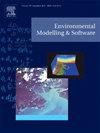具有能量依赖的广义s型种群增长模型:用于量化南极浅海底藻类临界点的应用
IF 4.8
2区 环境科学与生态学
Q1 COMPUTER SCIENCE, INTERDISCIPLINARY APPLICATIONS
引用次数: 0
摘要
s型增长模型常用于研究种群动态。处于平衡状态的种群规模通常明确地取决于资源的可用性,如能量或营养来源,这在标准的s型生长模型中并不明确。引入了一个简单的广义扩展的s型增长模型,可以明确地解释这种资源依赖,通过三个例子证明了这一系列模型的数学复杂性增加。每个模型都经过校准,并与南极沿海水域海冰下藻类的观测数据进行比较。研究发现,通过仔细构建模型,满足所提出的框架可以估计海冰爆发控制的藻类引爆点的关键特性,这是使用标准的s型生长模型无法估计的。提出的更广泛的能源依赖型s型增长模型可能适用于许多资源限制人口规模的人口增长环境。本文章由计算机程序翻译,如有差异,请以英文原文为准。
A generalised sigmoid population growth model with energy dependence: Application to quantify the tipping point for Antarctic shallow seabed algae
Sigmoid growth models are often used to study population dynamics. The size of a population at equilibrium commonly depends explicitly on the availability of resources, such as an energy or nutrient source, which is not explicit in standard sigmoid growth models. A simple generalised extension of sigmoid growth models is introduced that can explicitly account for this resource-dependence, demonstrated by three examples of this family of models of increasing mathematical complexity. Each model is calibrated and compared to observed data for algae under sea-ice in Antarctic coastal waters. It was found that through careful construction, models satisfying the proposed framework can estimate key properties of a sea-ice break-out controlled tipping point for the algae, which cannot be estimated using standard sigmoid growth models. The proposed broader family of energy-dependent sigmoid growth models likely has usage in many population growth contexts where resources limit population size.
求助全文
通过发布文献求助,成功后即可免费获取论文全文。
去求助
来源期刊

Environmental Modelling & Software
工程技术-工程:环境
CiteScore
9.30
自引率
8.20%
发文量
241
审稿时长
60 days
期刊介绍:
Environmental Modelling & Software publishes contributions, in the form of research articles, reviews and short communications, on recent advances in environmental modelling and/or software. The aim is to improve our capacity to represent, understand, predict or manage the behaviour of environmental systems at all practical scales, and to communicate those improvements to a wide scientific and professional audience.
 求助内容:
求助内容: 应助结果提醒方式:
应助结果提醒方式:


